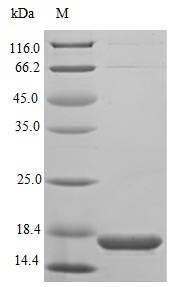The recombinant Mouse Ecel1 protein expression in e.coli cells requires the insertion of a DNA fragment encoding the Mouse Ecel1 protein (1-61aa) into a plasmid vector and the transferral of this vector into e.coli cells. The positive cells are screened, cultured, and then induced to express the Ecel1 protein. The protein carries a N-terminal 10xHis tag and C-terminal Myc tag. The cells are lysed to harvest the recombinant Mouse Ecel1 protein, which is purified through affinity purification and then detected by SDS-PAGE and subsequent staining of the gel with Coomassie Brilliant Blue. The purity of this recombinant Mouse Ecel1 protein is over 85%.




